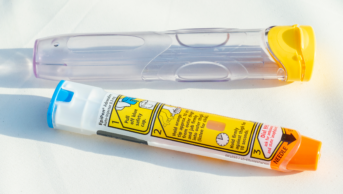
Shutterstock.com
More than 90% of oral medications frequently prescribed in the United States contain inactive ingredients that could cause adverse reactions, a study has found.
The study, which was published in the journal Science Translational Medicine
on 13 March 2019, analysed US data on the inactive ingredients found in 42,052 oral medicines. These were defined as substances added to a pill’s formulation that are not intended or expected to have a direct biological or therapeutic effect.
The average tablet or capsule was found to contain 280mg of inactive ingredients and only 164mg of active pharmaceutical ingredient, meaning that a patient taking 10 prescription medications could ingest an average of 2.8g of inactive ingredients daily.
Overall, researchers found a total of 38 inactive ingredients previously described as causing allergic symptoms after oral exposure and, of the medicines analysed, 92.8% contained at least one of these ingredients.
Chemical food dyes associated with allergic reactions, such as tartrazine, were found in 33% of the medicines.
Lactose was found in 45% of all oral solid dosage forms, including all available rosuvastatin and diclofenac tablets, with lactose content reaching close to 600mg per pill.
It was also found that 100% of progesterone and 62.5% of valproic acid capsules contained peanut oil as a solubiliser and could consequently not be taken by patients with peanut allergies, which, the researchers said, limited the therapeutic opportunities.
The researchers also discussed irritable bowel syndrome (IBS), which is increasingly being managed by starting a diet that is low in fermentable oligosaccharides, disaccharides, monosaccharides and polyols (FODMAPs). They discovered that 55% of all oral medications contained at least one FODMAP in their formulation, and 5% contained more than one FODMAP, with quantities sometimes exceeding 500mg per pill, which they said could cause potential discomfort in patients with IBS.
In addition, the researchers found that 18% of manufacturers indicated that their medications contained gluten and, although 69% claimed to produce gluten-free products, only 17% had proof that they had tested their products.
Giovanni Traverso, one of the authors of the study, said that the project was inspired by a real-life incident where a patient with coeliac disease was prescribed a medication that had gluten in it.
“When you’re a clinician, the last thing you want to do is prescribe a medication that could cause an adverse reaction or allergic reaction in a patient … we wanted to understand the problem and drill down to characterise the entire universe of inactive ingredients across thousands of drugs,” he said.
The researchers said that the amount of individual inactive ingredients in pills or capsules is largely not reported by manufacturers and therefore is not easily accessible to patients and healthcare providers.
“What is really striking about this data set is its complexity,” said Daniel Reker, lead author of the study.
“There are hundreds of different versions of pills or capsules that deliver the same medication using a different combination of inactive ingredients.
“This highlights how convoluted the possible choices of inactive ingredients are, but also suggests that there is a largely untapped opportunity today to specifically select the most appropriate version of a medication for a patient with unusual sensitivities.”


